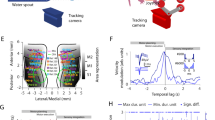Abstract.
Does the observation of well-timed movements imply the existence of some internal representation of time, such as a hypothetical neural clock? Here we report the results of experiments designed to investigate whether subjects form a correct adaptive representation of mechanical environments that change in a very predictable manner. In these experiments, subjects were asked to execute arm movements over a two-dimensional workspace while experiencing time-dependent disturbing forces. We provide a formal definition for time representation and conclude that our subjects didn't use time representation for motor adaptation under the tested conditions.
Subjects performed arm-reaching movements in the following experiments: (1) six experiments in a sinusoidal time-varying force field; (2) six experiments in a simple sequence of alternating viscous force fields, in which the number of targets allowed for the approximation of the force by a complex state-dependent force field; and (3) six experiments in the same simple sequence of alternating viscous force fields, in which no state-dependent force field approximation was possible. We found that the subjects did not adapt to the time-varying force field and were unable to form an adequate representation of the simple sequence of force fields. In the latter case, whenever possible, they adapted to a single state-dependent field that produced forces similar to the two alternating fields. This state-dependent field produced the same forces as the applied sequence of fields only over the trajectories that subjects executed during the training phase. However, the state-dependent field was inadequate to produce the correct forces generated by the field sequence over a new set of trajectories.
These results are not consistent with the hypothesis that subjects would develop a correct representation of time-dependent forces, at least under the tested circumstances. We speculate that the system responsible for adaptation of movements to external forces may be unable to employ temporal representation. While it is possible that such a representation may emerge in a more prolonged and/or intense training, our findings indicate a preference by the adaptive system to generalize based on representing dependence of external forces upon state rather than upon time.
Similar content being viewed by others
Author information
Authors and Affiliations
Additional information
Received: 23 April 2002 / Accepted: 21 January 2003 / Published online: 20 May 2003
RID="*"
ID="*" This study was done at the Robotics lab of the Rehabilitation Institute of Chicago
Correspondence to: A. Karniel (e-mail: karniel@ee.technion.ac.il, Tel.: +972-4-8294803, Fax: 972-4-8323041)
Acknowledgements. The authors are grateful to Emilio Bizzi, Ron Kettner, Enrico Mugnaini, Camillo Padoa-Schioppa, Jim Patton, and Sara Solla for their useful comments on an earlier version of the manuscript. We also acknowledge the support provided by the Ralph & Marion C. Falk Research Trust Fund, NIH 5 P50 MH48185, and NIH-NIDS NS35673.
Rights and permissions
About this article
Cite this article
Karniel, A., Mussa-Ivaldi, F. Sequence, time, or state representation: how does the motor control system adapt to variable environments?. Biol. Cybern. 89, 10–21 (2003). https://doi.org/10.1007/s00422-003-0397-7
Issue Date:
DOI: https://doi.org/10.1007/s00422-003-0397-7




